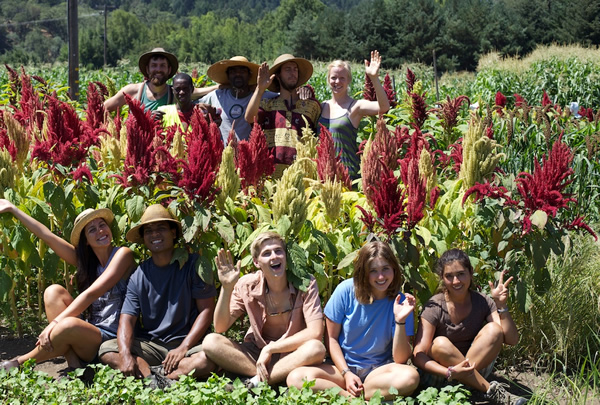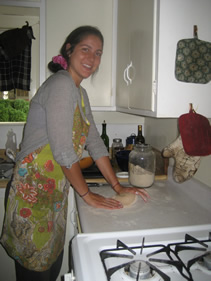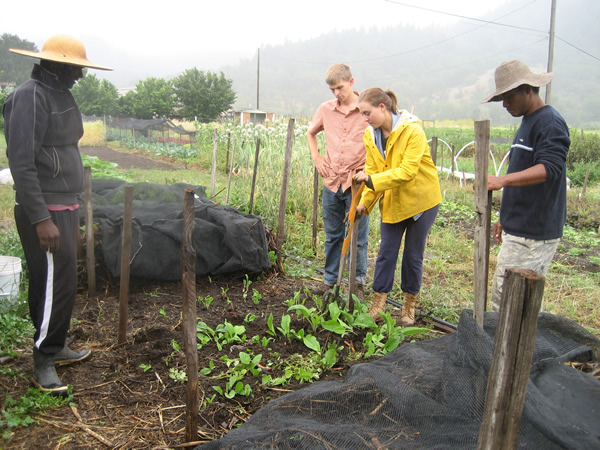Golden Rule Mini-Farm is the living and working environment for 8 of the international and US interns being trained by Ecology Action in 2013. There are an additional 5 interns at EAH Mini-Farm and 5 more at Green Belt Mini-Farm. These latter will be introduced in the next newsletter.

Staff and Interns at the Golden Rule Mini-Farm.
Front row, from left:Mina, Louis, Jack, Lucy, Isa. Back row, from left: Luke, N'famara, Don, Clement, Rachel. Away on vacation: Ellen
Most mornings between April and November when you visit the Golden Rule Mini-Farm, you'll observe pretty much the same routine. Between 7:30 and 8:00 a.m., you'll find staff people Ellen Bartholomew, Luke Howerter and Rachel Britten planning the shape of the day and the tasks to be accomplished by the EA interns. The June day I came to visit happened to be the last day of an unusual weather system that brought about 2 inches of rain to this mini-farm south of Willits. The garden was soaked, and it was still drizzling.
Rachel told me the pattern of delegation for the day remains the same, rain or shine. Assignments are posted in the barn at 8:00 a.m. for both the six 6-month and two 2-month interns. On this day, the morning's assignment for everyone is: 1) Instruction in bread baking, 2) "The Great Flat Clean-up," and 3) Grain and bean processing.
This is the formal plan, though I soon witness there's so much that happens informally, with smallerassignments to individual interns and interactions between interns and staff, that the learning environment is almost palpable.
Making Bread
 Once the interns are assembled and staff has reviewed the plan of the day, Luke leads the group to one of the intern kitchens, where bread dough, started the night before, has risen and will be kneaded by the interns, to rise again. Master bread-maker Luke explains the chemistry of yeasts and bread-making, which is important to the interns because of their need to plan a 40-bed-unit garden which will meet all their calorie needs over the course of a year. Grains and bread play a key role in this diet. Adding flour and salt, Luke demonstrates how to knead the dough and to test when the gluten has been worked enough. Then two of the interns practice the skill as the others look on.
Once the interns are assembled and staff has reviewed the plan of the day, Luke leads the group to one of the intern kitchens, where bread dough, started the night before, has risen and will be kneaded by the interns, to rise again. Master bread-maker Luke explains the chemistry of yeasts and bread-making, which is important to the interns because of their need to plan a 40-bed-unit garden which will meet all their calorie needs over the course of a year. Grains and bread play a key role in this diet. Adding flour and salt, Luke demonstrates how to knead the dough and to test when the gluten has been worked enough. Then two of the interns practice the skill as the others look on.
Diet planning is a key aspect of the GROW BIOINTENSIVE system and an important part of intern training. Each intern learns to figure out how many calories they need each day and designs a diet they'd like to eat, including how much food they'd need to grow to live off their farm and the number of garden beds needed per year to supply this dietary requirement.
Mina kneading dough in the intern kitchen
If the only requirement of a mini-farm were food for a balanced diet, the training of the method would be simpler. But interns soon learn that a GB mini-farm must also grow enough compost material to maintain soil fertility without importing materials from outside, and may also grow crops to market for a small income. When the interns arrive at the Golden Rule in April, they immediately plan and plant three beds, which mirror, in microcosm, the 60%-30%-10% proportions (explained below) needed for a sustainable mini-farm. They will take care of these beds for the next six months
"The Great Flat Clean-up"
While the bread rises again, "The Great Flat Clean-up" takes place. Rachel explains it's the time of the year when staff and interns have found a space for every possible seedling, and now it's time to let the rest go. (An important feature of GROW BIOINTENSIVE is that most crops are started in flats and transplanted into the garden, unlike planting methods used in most traditional cultures.)
During the flat clean-up, there are side assignments taking place, part of what makes for an especially rich learning environment, and an opportunity for interns to work and laugh together. (Luckily, English is the common language, along with two secondary languages: Spanish, which is often spoken, and French, spoken between Clement and N'famara.)
Two of the 6-month interns, Louis Falmngar and Don Weerakkody (who have already been here three months), are showing the newly arrived 2-month US interns, Lucy Kramer and Jack Murphy, how to construct a compost pile. The "6-monthers" get to teach the skill, and the new interns get to practice. First they prepare the soil to serve as the base of the pile. Next they position a layer of small branches to allow aeration at the base. Then they alternate layers of green (immature) and dry (mature) materials, and soil, with each layer being watered before the next layer is added.

Louis and Don mentor as Lucy and Jack construct a compost pile.
After lunch, Jack and Lucy listen to further refinements about composting materials, as they harvest February-planted fava bean plants for compost. Luke explains the difference between mature and immature materials. Mature material comes from crops that have gone to full maturity (like wheat straw), which means that it is more resistant to decomposition, whereas immature material is more easily decomposed (like lawn grass) and helps the microorganisms break down the mature material. The fava bean plants in question have started to form beans that are too young for food, so the entire plants will go into the compost pile. This means that they fall somewhere in the middle of the spectrum between immature and mature.
Lunch
Following the flat clean-up, there's another splitting off of assignments: Don and Luke, who are signed up on the "Lunch Prep" calendar, are off to the kitchen to plan and prepare lunch. This is just one aspect of what Rachel describes as the experiential, multi-layered, cross-cultural learning environment that results from living and working together as a group. For example, lunch provides an opportunity for interns:
- To use the fresh produce from the garden to provide a complete vegetarian diet for a group of from 10 to 15 people;
- To learn to grind and prepare different grains and season them to make them tasty;
- To discover what foods people eat in different countries, how they cook, and even the gender roles around domestic activities.
Lunch on this day is a seasoned polenta, ground from Cascade Ruby Gold corn; a tasty dish of beans and kale; and a salad, fresh from the garden.
Grain and Bean Processing
While the cooks are working on lunch, the other interns take on the processing of grains and beans, an activity that appropriately takes place on the second floor of the barn. Here is where rows of different grains are h anging to dry before they'll be weighed to provide biomass data for the carbon-farming component of the GB system. Interns can be observed in various activities, while Ellen talks about how the GR Mini-Farm has expanded this past year. Interns bundle grains head down, keeping grain stalks in place. Beans are maneuvered out of their pods using different strategies, and a big fan is used to winnow chaff and pods from grains and beans.
anging to dry before they'll be weighed to provide biomass data for the carbon-farming component of the GB system. Interns can be observed in various activities, while Ellen talks about how the GR Mini-Farm has expanded this past year. Interns bundle grains head down, keeping grain stalks in place. Beans are maneuvered out of their pods using different strategies, and a big fan is used to winnow chaff and pods from grains and beans.
All three staffers at Golden Rule—Ellen, Luke and Rachel—love growing grains. In response to this passion, they worked this past year (with the help of Ellen's husband Brian) to triple the size of the garden and enclose it with a tall, deer-proof fence.
In the expanded section, there's ample space for more grains. Currently, there is red wheat, white wheat, purple barley and oats. In addition, there are over 350 tomato plants and two large greenhouses, newly constructed with the help of Ellen's son Cody, that can be moved using several people. Ellen has offered some of the expanded garden space to support other local agricultural activities, including food for the hospital in Willits and a new experimental market garden operated by John Keleher, a 2-month intern at EA in 2012.
Isa (left) and Ellen prepare to hang bundled grain to dry
Collective Afternoon Activities
Often in the afternoon after lunch, the group works together on certain collective activities. On this afternoon, there are three group activities. One is working with grains: identifying when oats are ready to harvest and how to harvest them. The second activity is learning about the genetic diversity of amaranth and saving amaranth seed. The task today is to identify and remove rogue amaranth plants because you don't want them to cross with the principal seed you are saving. The third activity for the afternoon is learning to deal with the Harlequin beetle, a pest that damages tree collards and other plants. Interns practice manually picking off and killing the beetles. Rachel tells interns that if you have enough diversity in your garden, you will usually not have serious pest problems. At the Golden Rule, the garden is alive with diversity, and even seems to attract a diversity of birds and beneficial insects.
Dinner and the End of the Day
The late afternoon and evening at the GR Mini-Farm is when activities wind down. Following the afternoon tasks, the group walks a short distance to the community dining hall and eats dinner prepared by Golden Rule community members. Usually, two of the interns assist with clean-up and mingle with the community.
On my second visit, it has been a hot day, so watering takes place after dinner. This can be a reflective time, sometimes quieter, when an intern gets to study the plants and beds he or she is tending. But it's as likely to be a chance for singing and banter, as the plants soak up as much water as they need to thrive.
On this particular night, interns and staff don't retire yet to their own room at intern housing. It's Tuesday night, house meeting night. This meeting is the time for announcements by Luke and Rachel, and for the interns to bring up issues they want to deal with, from household repairs to establishing rules for upkeep of communal housing. The role of facilitator for the meeting is traded around, so everyone gets a chance to try out this role. Scheduling is a key factor at the house meetings. There are cooking and cleaning schedules, watering schedules, interesting field trips to sign up for, plus vacation schedules to coordinate.
It's a long day at the mini-farm, and interns and staff are tired, yet, at day's end—with all the learning that's been seen, touched, heard and experienced— I sense a kind of aliveness and vibrancy, within this plant/human/creature community, that would be difficult to find anywhere else!